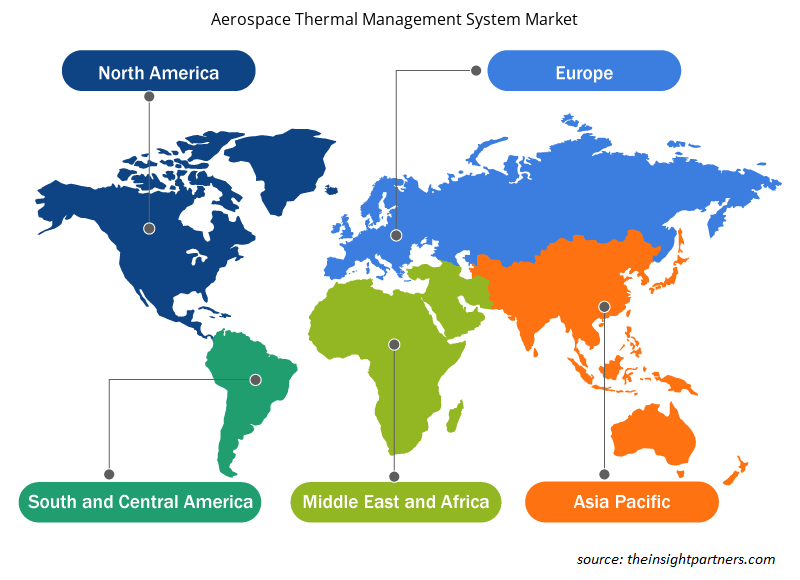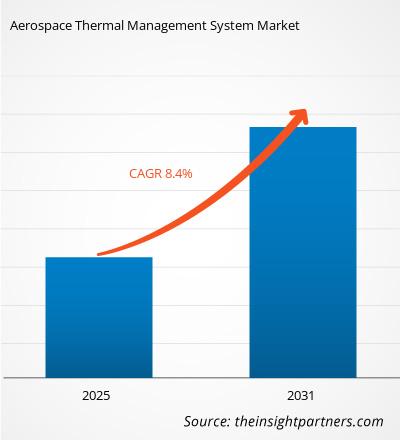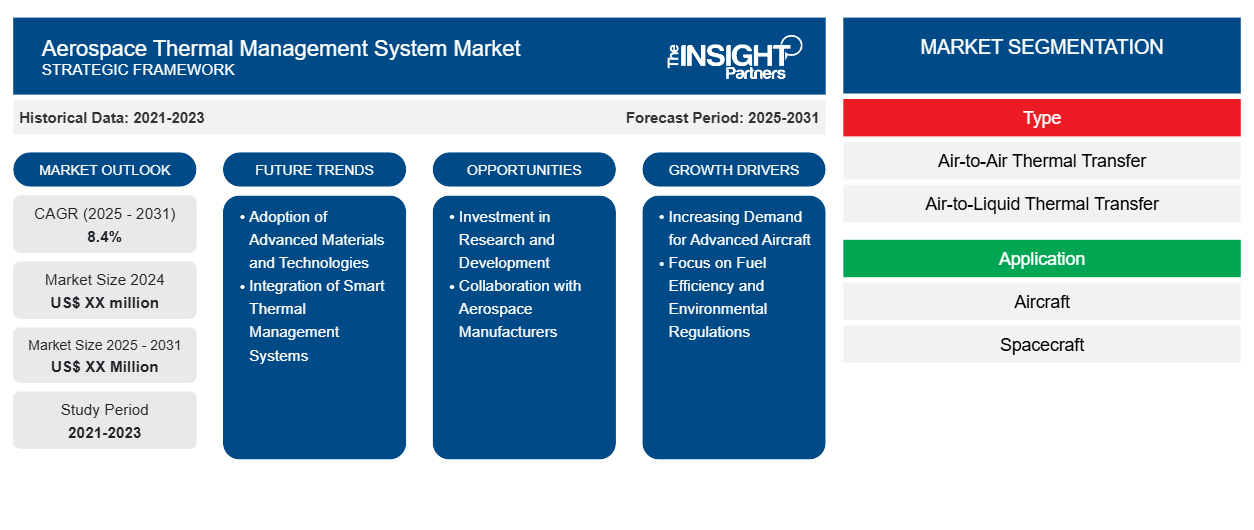Le marché des systèmes de gestion thermique aérospatiale devrait enregistrer un TCAC de 8,4 % de 2024 à 2031, avec une taille de marché passant de XX millions USD en 2024 à XX millions USD d'ici 2031.
Le marché est segmenté en type et en application. Le segment type est divisé en transfert thermique air-air, transfert thermique air-liquide. En fonction de l'application, le marché mondial des satellites militaires est segmenté en aéronefs et engins spatiaux.
Objectif du rapport
Le rapport sur le marché des systèmes de gestion thermique aérospatiale de The Insight Partners vise à décrire le paysage actuel et la croissance future, les principaux facteurs moteurs, les défis et les opportunités. Cela fournira des informations à diverses parties prenantes commerciales, telles que :
- Fournisseurs/fabricants de technologie : pour comprendre l’évolution de la dynamique du marché et connaître les opportunités de croissance potentielles, leur permettant de prendre des décisions stratégiques éclairées.
- Investisseurs : Effectuer une analyse complète des tendances concernant le taux de croissance du marché, les projections financières du marché et les opportunités qui existent tout au long de la chaîne de valeur.
- Organismes de réglementation : Réglementer les politiques et surveiller les activités du marché dans le but de minimiser les abus, de préserver la confiance des investisseurs et de maintenir l’intégrité et la stabilité du marché.
Segmentation du marché des systèmes de gestion thermique pour l'aérospatiale
Taper
- Transfert thermique air-air
- Transfert thermique air-liquide
Application
- Aéronef
- Vaisseau spatial
Personnalisez ce rapport en fonction de vos besoins
Vous bénéficierez d'une personnalisation gratuite de n'importe quel rapport, y compris de certaines parties de ce rapport, d'une analyse au niveau des pays, d'un pack de données Excel, ainsi que de superbes offres et réductions pour les start-ups et les universités.
-
Obtenez les principales tendances clés du marché de ce rapport.Cet échantillon GRATUIT comprendra une analyse de données, allant des tendances du marché aux estimations et prévisions.
Facteurs de croissance du marché des systèmes de gestion thermique pour l'aérospatiale
- Demande croissante d'avions de pointe : l'industrie aérospatiale évolue en permanence, les fabricants se concentrant sur le développement d'avions de pointe offrant des performances, une efficacité et une sécurité améliorées. À mesure que les avions deviennent plus complexes et intègrent des technologies de pointe, le besoin de systèmes de gestion thermique efficaces devient crucial. Ces systèmes sont essentiels pour maintenir des températures de fonctionnement optimales pour divers composants, tels que l'avionique, les moteurs et les systèmes de carburant. La demande croissante d'avions de pointe, notamment d'avions commerciaux, d'avions militaires et de véhicules aériens sans pilote (UAV), stimule le marché des systèmes de gestion thermique aérospatiaux.UAVs), is driving the aerospace thermal management system market.
- L'accent est mis sur l'efficacité énergétique et les réglementations environnementales : L'accent est de plus en plus mis sur l'efficacité énergétique et le respect des réglementations environnementales dans le secteur aéronautique. Les systèmes de gestion thermique jouent un rôle crucial dans l'optimisation des performances des moteurs et la réduction de la consommation de carburant. En maintenant des températures optimales, ces systèmes peuvent améliorer l'efficacité des moteurs et réduire les émissions, aidant ainsi les fabricants à se conformer à des normes environnementales strictes. À mesure que les gouvernements et les organismes de réglementation mettent en œuvre des objectifs d'émissions plus rigoureux, la demande de solutions de gestion thermique efficaces devrait augmenter.
Tendances futures du marché des systèmes de gestion thermique pour l'aérospatiale
- Adoption de matériaux et de technologies de pointe : Le marché de la gestion thermique aérospatiale connaît une tendance à l'adoption de matériaux et de technologies de pointe, tels que les matériaux à changement de phase (PCM), les nanofluides et les échangeurs de chaleur avancés. Ces matériaux et technologies offrent des performances et une efficacité thermiques améliorées, permettant un contrôle de température plus efficace dans les applications aérospatiales. L'utilisation de matériaux légers est particulièrement importante dans l'aérospatiale pour réduire le poids global et améliorer le rendement énergétique, ce qui rend les solutions de gestion thermique avancées de plus en plus attrayantes pour les fabricants.
- Intégration de systèmes de gestion thermique intelligents : Il existe une tendance croissante vers l'intégration de systèmes de gestion thermique intelligents qui exploitent des données en temps réel et des analyses avancées pour optimiser les performances thermiques. Ces systèmes peuvent surveiller la température, la pression et d'autres paramètres, ce qui permet des ajustements proactifs pour maintenir des conditions de fonctionnement optimales. L'intégration des technologies IoT (Internet des objets) permet une surveillance à distance et une maintenance prédictive, améliorant ainsi la fiabilité et l'efficacité des systèmes de gestion thermique dans les applications aérospatiales.
Opportunités de marché des systèmes de gestion thermique pour l'aérospatiale
- Investissements dans la recherche et le développement : les investissements continus dans la recherche et le développement (R&D) pour créer des technologies de gestion thermique innovantes offrent des opportunités importantes sur le marché de l'aérospatiale. Les progrès dans la science des matériaux, les solutions de stockage thermique et les technologies de transfert de chaleur peuvent conduire au développement de systèmes de gestion thermique plus efficaces et plus performants. Les entreprises qui accordent la priorité à la R&D et se concentrent sur l'innovation seront bien placées pour répondre aux besoins en constante évolution de l'industrie aérospatiale et acquérir un avantage concurrentiel.
- Collaboration avec les fabricants de l'industrie aérospatiale : les fournisseurs de systèmes de gestion thermique ont la possibilité de collaborer avec les fabricants de l'industrie aérospatiale pour développer des solutions personnalisées qui répondent à des exigences opérationnelles spécifiques. En travaillant en étroite collaboration avec les fabricants d'avions et d'autres acteurs du secteur, les entreprises de gestion thermique peuvent créer des systèmes sur mesure qui améliorent les performances, l'efficacité et la sécurité. Ces collaborations peuvent conduire à des partenariats à long terme et à une augmentation des parts de marché pour les entreprises qui proposent des solutions de gestion thermique innovantes et efficaces.
Aperçu régional du marché des systèmes de gestion thermique pour l'aérospatiale
Les tendances et facteurs régionaux influençant le marché des systèmes de gestion thermique aérospatiale tout au long de la période de prévision ont été expliqués en détail par les analystes d’Insight Partners. Cette section traite également des segments et de la géographie du marché des systèmes de gestion thermique aérospatiale en Amérique du Nord, en Europe, en Asie-Pacifique, au Moyen-Orient et en Afrique, ainsi qu’en Amérique du Sud et en Amérique centrale.

- Obtenez les données régionales spécifiques au marché des systèmes de gestion thermique aérospatiale
Portée du rapport sur le marché des systèmes de gestion thermique aérospatiale
| Attribut de rapport | Détails |
|---|---|
| Taille du marché en 2024 | XX millions de dollars américains |
| Taille du marché d'ici 2031 | XX millions de dollars américains |
| Taux de croissance annuel composé mondial (2025-2031) | 8,4% |
| Données historiques | 2021-2023 |
| Période de prévision | 2025-2031 |
| Segments couverts |
Par type
|
| Régions et pays couverts |
Amérique du Nord
|
| Leaders du marché et profils d'entreprises clés |
|
Densité des acteurs du marché des systèmes de gestion thermique aérospatiale : comprendre son impact sur la dynamique commerciale
Le marché des systèmes de gestion thermique aérospatiale connaît une croissance rapide, tirée par la demande croissante des utilisateurs finaux en raison de facteurs tels que l'évolution des préférences des consommateurs, les avancées technologiques et une plus grande sensibilisation aux avantages du produit. À mesure que la demande augmente, les entreprises élargissent leurs offres, innovent pour répondre aux besoins des consommateurs et capitalisent sur les tendances émergentes, ce qui alimente davantage la croissance du marché.
La densité des acteurs du marché fait référence à la répartition des entreprises ou des sociétés opérant sur un marché ou un secteur particulier. Elle indique le nombre de concurrents (acteurs du marché) présents sur un marché donné par rapport à sa taille ou à sa valeur marchande totale.
Les principales entreprises opérant sur le marché des systèmes de gestion thermique aérospatiale sont :
- AMETEK
- Société Boyd
- Collins Aerospace, une société de Raytheon Technologies Corporation
- Fondation Diehl et Cie. KG
- Elmelin Ltée
Avis de non-responsabilité : les sociétés répertoriées ci-dessus ne sont pas classées dans un ordre particulier.

- Obtenez un aperçu des principaux acteurs du marché des systèmes de gestion thermique aérospatiale
Principaux arguments de vente
- Couverture complète : Le rapport couvre de manière exhaustive l’analyse des produits, des services, des types et des utilisateurs finaux du marché des systèmes de gestion thermique aérospatiale, offrant un paysage holistique.
- Analyse d’experts : Le rapport est compilé sur la base d’une compréhension approfondie des experts et analystes du secteur.
- Informations à jour : Le rapport garantit la pertinence commerciale en raison de sa couverture des informations récentes et des tendances des données.
- Options de personnalisation : ce rapport peut être personnalisé pour répondre aux exigences spécifiques du client et s'adapter parfaitement aux stratégies commerciales.
Le rapport de recherche sur le marché des systèmes de gestion thermique aérospatiale peut donc aider à ouvrir la voie au décodage et à la compréhension du scénario de l’industrie et des perspectives de croissance. Bien qu’il puisse y avoir quelques préoccupations valables, les avantages globaux de ce rapport ont tendance à l’emporter sur les inconvénients.
- Analyse historique (2 ans), année de base, prévision (7 ans) avec TCAC
- Analyse PEST et SWOT
- Taille du marché Valeur / Volume - Mondial, Régional, Pays
- Industrie et paysage concurrentiel
- Ensemble de données Excel
Rapports récents
Rapports connexes
Témoignages
Raison d'acheter
- Prise de décision éclairée
- Compréhension de la dynamique du marché
- Analyse concurrentielle
- Connaissances clients
- Prévisions de marché
- Atténuation des risques
- Planification stratégique
- Justification des investissements
- Identification des marchés émergents
- Amélioration des stratégies marketing
- Amélioration de l'efficacité opérationnelle
- Alignement sur les tendances réglementaires























 Obtenez un échantillon gratuit pour - Marché des systèmes de gestion thermique aérospatiale
Obtenez un échantillon gratuit pour - Marché des systèmes de gestion thermique aérospatiale